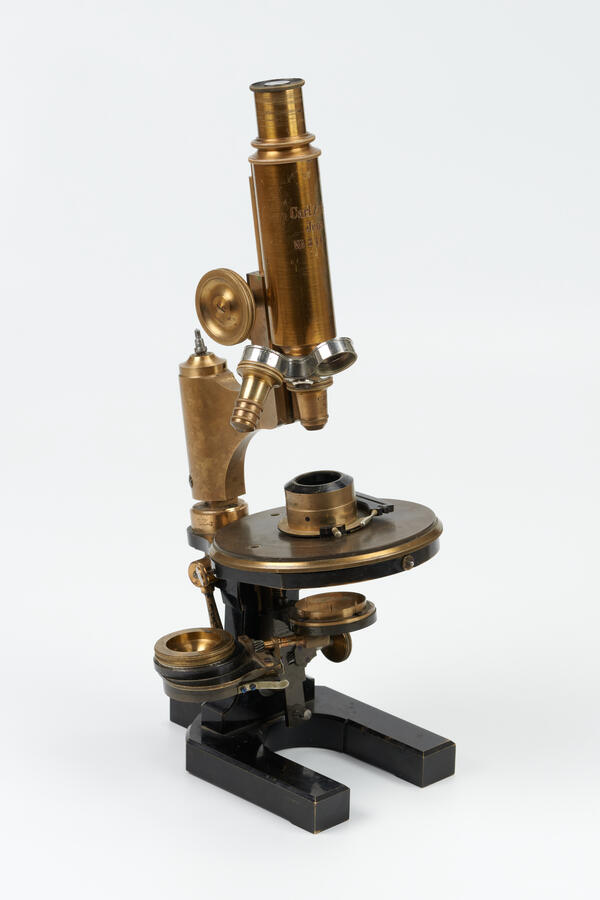A microscope was first mentioned in 1595. Zacharias Jansen, a son of a Dutch spectacle-maker Hans Jansen, made an unusual tube out of a metal cylinder and scraps of glass. When he looked through it at objects, he saw them magnified in several times. Zachary told his father about his discovery, and his father improved the device. Now, instead of one tube, there were several tubes inserted into each other. As the length of the tubes could be changed, it was possible to zoom in or out of the image and to examine small details. Some years later, Galileo Galilei learned about the magnifying tube and created on the basis of Jansen’s microscope his own, and later established the manufacture of the simplest microscopes.
Dutch naturalist Antonie van Leeuwenhoek, who became one of the founders of microbiology, improved the microscope in the 17th century. With the help of microscopes, Leeuwenhoek was the first to study and describe single celled organisms, yeast, red blood cells, skin scales. With the development of science and technology microscopes have become necessary tools for research.
The microscope, displayed in the Yershov Museum Complex of Ishim City, was manufactured at the Karl Zeiss Optical Systems factory.
Karl Friedrich Zeiss was a German engineer and optics manufacturer. He was born in 1816 in the family of a cabinetmaker in Weimar, Thuringia. He entered a gymnasium, graduated early, and moved to Jena, where he attended lectures on mathematics, physics, anthropology, optics, and mineralogy at a local university. He was working as a traveling sales agent for several years, and therefore visited many glass factories. Zeiss made many notes about glass melting methods, materials and required kilns temperatures. He was interested in everything related to glass, lenses, microscopes, and other optical instruments manufacturing.
Later, Karl Zeiss opened his own optics factory, and established the production of single-lens microscopes for experimental research in 1847. He managed to sell 23 microscopes during the first year. Then, Zeiss made the device more complex. The microscope Stand-1 appeared in 1858. It was equipped with a doublet lens objective, an internal lens, and an ocular with two lenses. Zeiss used a lighting system, he himself invented. In 1861, the inventor was awarded a gold medal at the Industrial Exhibition in Thuringia.
You can see the microscope at the permanent exhibition “Merchant’s stall”. The device consists of a base with a cross table, a brass foot, and a doublet lens eyepiece.
Dutch naturalist Antonie van Leeuwenhoek, who became one of the founders of microbiology, improved the microscope in the 17th century. With the help of microscopes, Leeuwenhoek was the first to study and describe single celled organisms, yeast, red blood cells, skin scales. With the development of science and technology microscopes have become necessary tools for research.
The microscope, displayed in the Yershov Museum Complex of Ishim City, was manufactured at the Karl Zeiss Optical Systems factory.
Karl Friedrich Zeiss was a German engineer and optics manufacturer. He was born in 1816 in the family of a cabinetmaker in Weimar, Thuringia. He entered a gymnasium, graduated early, and moved to Jena, where he attended lectures on mathematics, physics, anthropology, optics, and mineralogy at a local university. He was working as a traveling sales agent for several years, and therefore visited many glass factories. Zeiss made many notes about glass melting methods, materials and required kilns temperatures. He was interested in everything related to glass, lenses, microscopes, and other optical instruments manufacturing.
Later, Karl Zeiss opened his own optics factory, and established the production of single-lens microscopes for experimental research in 1847. He managed to sell 23 microscopes during the first year. Then, Zeiss made the device more complex. The microscope Stand-1 appeared in 1858. It was equipped with a doublet lens objective, an internal lens, and an ocular with two lenses. Zeiss used a lighting system, he himself invented. In 1861, the inventor was awarded a gold medal at the Industrial Exhibition in Thuringia.
You can see the microscope at the permanent exhibition “Merchant’s stall”. The device consists of a base with a cross table, a brass foot, and a doublet lens eyepiece.



